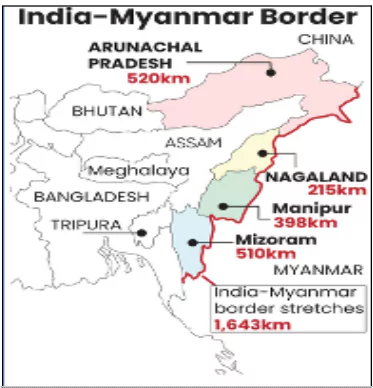The civil war in Myanmar has led to an influx of refugees into India, particularly along the Moreh border in Manipur.
Refugee Influx into Manipur
- Since January 27, 2025, approximately 260 Myanmar refugees have sought shelter in India.
- Refugees began arriving in batches from January 9, 2025, due to airstrikes conducted by Myanmar’s military.
- Initially, around 100 individuals sought temporary refuge but returned after the bombings subsided.
- Between January 27 and January 29, an intensified conflict in Myanmar resulted in 261 additional refugees arriving in Manipur, who have yet to return.
Enroll now for UPSC Online Course
United Nations Refugee Convention 1951
- Multilateral Treaty: Defines who qualifies as a refugee and lays out asylum rights and responsibilities of asylum-granting nations.
- Exclusions: War criminals and certain others do not qualify as refugees.
- Protection: Provides rights to individuals fleeing persecution due to race, religion, nationality, social group, or political opinion.
- Based on the Universal Declaration of Human Rights (UDHR), 1948: Builds on Article 14, which recognizes the right to seek asylum.
- 1967 Protocol: Expands the refugee definition to include individuals from all countries, not just Europe.
United Nations High Commissioner for Refugees (UNHCR)
- Purpose : Protects refugees, displaced communities, and stateless individuals.
- Established in 1950: Originally to assist displaced Europeans after World War II.
- Headquarters: Geneva, Switzerland.
- Mission: To save lives, provide protection, and work toward a better future for refugees.
|
Legal Definition of a Refugee
- As per the 1951 Geneva Convention, a refugee is someone who, owing to a well‐founded fear of persecution based on race, religion, nationality, membership in a particular social group, or political opinion, is outside their country of nationality and unable or unwilling to return due to such fear.
Lack of Legal Provisions for Refugees in India
- Absence of National, Regional, or International Framework : India and most South Asian nations lack a formal refugee policy, and the government has never officially explained this absence.
- Refugee management is handled through ad hoc measures rather than structured legal frameworks.
Reason for Lack of legal provision
- Skepticism Towards the 1951 Refugee Convention: India chose not to sign the 1951 Convention or the 1967 Protocol, fearing international interference in domestic affairs.
- The Partition of 1947 and its social upheaval did not fit the Convention’s definition of state-sponsored persecution, leading to long-standing skepticism toward global refugee policies.
- Historical Experience of Refugee Crises: The 1971 Bangladesh Liberation War brought millions of refugees to India, straining resources. India expected international aid but received minimal support, reinforcing its reluctance to depend on global refugee mechanisms.
- Geopolitical and Security Concerns : Porous borders, demographic shifts, political instability, and internal security threats make India wary of legally binding refugee commitments. Accepting refugees formally could invite international scrutiny on domestic issues.
- Selective Refugee Policy & Political Influence : India grants asylum based on diplomatic and political considerations rather than universal legal principles. The government selectively provides protection, often influenced by religion, nationality, and geopolitical interests.
Check Out UPSC CSE Books From PW Store
India-Myanmar Border Overview

- Total Length : 1,643 km
- Shares border with following Indian states:
- Arunachal Pradesh : 520 km border with Myanmar.
- Nagaland : 215 km border with Myanmar.
- Manipur : 398 km border with Myanmar.
- Mizoram: 510 km border with Myanmar.
Manipur’s Borders
- Indian States
- Nagaland: North of Manipur.
- Assam: West of Manipur.
- Mizoram: Southwest of Manipur.
- International Borders
- Myanmar : South and east of Manipur.
Factors Responsible for the Refugee Crisis at the India-Myanmar Border
- Myanmar Civil War & Military Operations: Ongoing conflict between Myanmar’s military junta and resistance groups, including frequent airstrikes, forces civilians to flee.
- Ethnic Persecution & Violence: Ethnic minorities like the Kuki-Zo face targeted attacks, escalating displacement.
- Political Instability & Insurgencies: The post-coup turmoil has fueled insurgencies, worsening border tensions.
- Unclear Refugee Policy in India : The absence of a formal framework makes managing and integrating refugees difficult.
- Border Clashes & Humanitarian Crisis : Armed conflicts near Manipur and inadequate access to food, shelter, and healthcare exacerbate the crisis.
Enroll now for UPSC Online Classes
Way Forward
- Humanitarian and Security Measures : Set up temporary shelters, provide medical aid, and ensure humane border security.
- Diplomatic and Policy Frameworks: Strengthen diplomatic efforts with Myanmar, ASEAN, and UN agencies; establish a clear refugee policy.
- International and Community Collaboration: Work with UNHCR and local communities to manage refugee influx and prevent ethnic tensions.
- Long-Term Solutions: Develop rehabilitation plans for economic integration or safe repatriation when conditions improve.
- Conflict Resolution in Myanmar: India should facilitate peace talks and support democratic restoration to ensure regional stability.
Ready to boost your UPSC 2025 preparation? Join PW’s UPSC online courses today!
![]() 4 Feb 2025
4 Feb 2025



